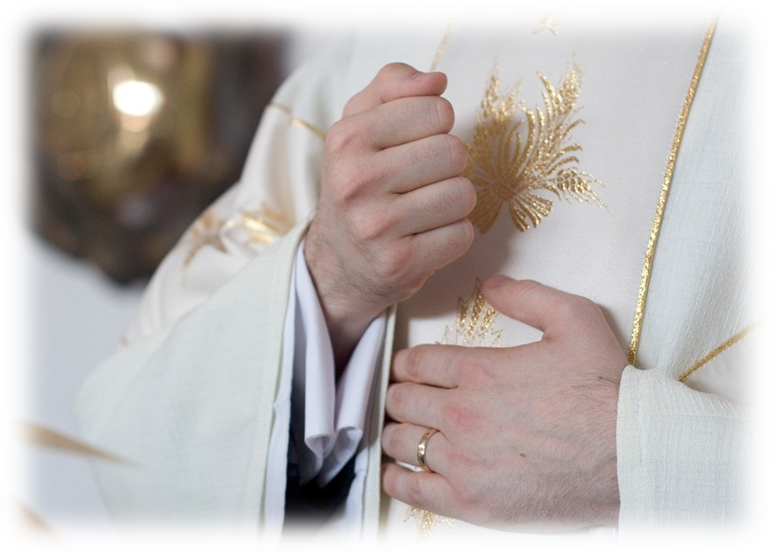
Mea culpa, mea culpa, mea maxima culpa
Let’s try to understand individual parts of Holy Mass
The Church, which is holy and at the same time a community of sinners, is conscious that her members need a continuous conversion to ask God’s forgiveness and to worthily participate in the sacred mysteries. This explains how from the very beginning public repentance of one’s sin was necessary before the Eucharistic celebration so that the sacrifice be pleasing to God. The Penitential Act is a concrete expression of this reality by the priest and the faithful, who humbly recognize their sins. They repent and implore God’s mercy so that they may participate fruitfully in the sacred mysteries.
In the Didache, a document composed towards the end of the first century, is written: “Gathered together on the Lord’s day, break bread and give thanks, after having confessed your sins, so that your sacrifice may be pure.”
As we can see, the beginnings of the penitential act at the opening of Mass are found in the ancient liturgical books. It was soon to be expressed with the prostration of the priest in front of the altar, it only takes place now in the celebration of the Lord’s passion on Good Friday. Around the 10th century, this rite is included in the missals and consists in the priest’s recitation of a few prayers that manifest his feelings of unworthiness as the minister of the Holy Sacrifice. Only in Paul VI’s Missal is this rite extended to the entire community. Up until then only the priest did so.
On Sundays, especially during Easter time, the penitential act can take the form of sprinkling holy water. This is to remind us of our baptism and to invite us to a continual purification, as the living of this sacrament demands.
Confiteor, the I confess
“I confess to almighty God. . .”. Frequently, with malevolence, pious Christians are accused of being sinners, “in spite of going to Mass so much.” Well, those who frequently receive the Eucharist must be the most convinced of our condition as sinners, which we confess at Mass, “Through my own fault.” This is precisely why we receive communion frequently, because we know that we are sinners. This is why we begin the celebration with a humble petition for God’s forgiveness. He is the only one who can take the stain of our sins from our conscience. To receive this forgiveness, we also ask, “the blessed Mary, ever virgin, all the angels and saints, and you, my brothers and sisters, to pray for me to the Lord our God.”
This could give the impression that the Confiteor is an obligatory part of the Introductory Rites of the Eucharist. However, it is not that simple. The prayer is an option and not obligatory in the current form of the Roman Missal.
Lord, Have Mercy – Kyrie eleison
“May almighty God have mercy on us, forgive us our sins, and bring us to everlasting life.” This beautiful liturgical prayer, which the priest says, does not absolve all sins with the ex opere operato efficacy characteristic of the sacrament of penance (Confession). It is rather a petition, such that, through the beseeching mediation of the Church and through the personal acts of those assisting at the Eucharist, the small sins of every day are forgiven. In this way the faithful are kept from falling into graver sins.
The insertion, in one way or another, of the Kyrie in the liturgy is very old. Around 390, the Galician pilgrim Egeria, in her Pilgrimage Diary, describes these acclamations in the Church of the Resurrection in Jerusalem, “A deacon reads the intentions and a great number of children respond, ‘Kyrie eleison.’ Their voices form an unending echo.” (XXIV,4)
The General Instruction Roman Missal says, “It is a chant by which the faithful acclaim the Lord and implore his mercy” (GIRM,30) In it, we speak of the lordship, royalty and divinity of Jesus Christ. We go to Him, as in His public life, imploring His mercy.
The Gospel frequently shows us people who invoke Christ as Lord, seeking His mercy: the Canaanite woman, “Have mercy on me, O Lord, Son of David.” (Mt. 15:22); the two blind men from Jericho, “Have mercy on us, Son of David” (Mt. 20,30-31); or the ten lepers, (Lk. 17:13).
In this sense, the Kyrie eleison (Lord, have mercy), asking six times for the mercy of Christ, as Lord, are on one hand a prolongation of the proceeding penitential act; on the other hand, they are a joyful proclamation of Christ, as Lord of the universe, and in this sense they become a prologue of the ‘Glory to God in the Highest’ that follows. In effect, Christ humbled Himself for our sake. He was obedient unto death on the cross, and now after His resurrection, “every tongue should confess that Jesus Christ is Lord, to the glory of God the Father.” (Phil. 2:11)